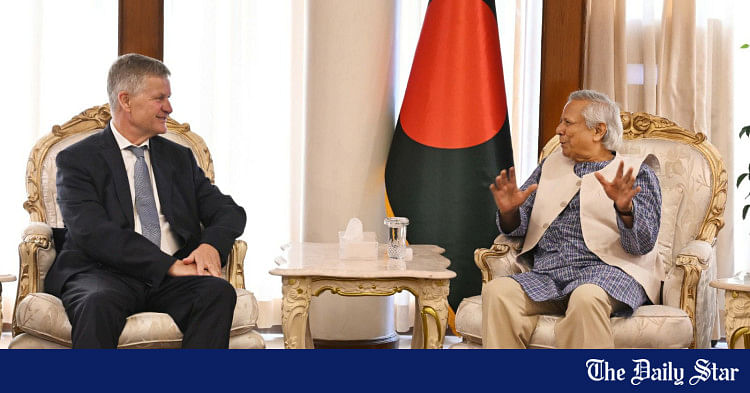Bangladesh's energy security and sustainability
A bubble waiting to burst
Zaved Akhtar
Published :
Mar 05, 2025 22:44
Updated :
Mar 05, 2025 22:44
The government has been in a dilemma regarding the energy security of the country. At one hand it has a large amount pending dues in the middle eastern markets for energy which we had secured earlier while we are struggling to pay local Independent Power Providers and local gas supplier, i.e., Chevron. Today our energy tenders are not being responded as this require a sovereign guarantee or we need to pay significant risk premium for anyone to touch it with a pole. At the same time, we have the warm season impending summer coming back when local demands will peak while we struggle to supply the gas guzzling manufacturing industries. Such catch-22 situation (a dilemma or difficult circumstance from which there is no escape because of mutually conflicting or dependent conditions) which makes it very difficult for the power regulators to manage. This is leading to regulators contemplating unprecedentedgas price hikes.
The new gas pricing proposed by Petrobangla aims to reflect the actual cost of imported LNG with price proposal set at Tk 75.72 per cubic meter, an increase of over 150 per cent (current rate of Tk 30.75 per cubic meter). The intent is to reduce the significant fiscal burden on the Government estimated to be Tk 160b in FY 2025. However, the new price will not be effective for all connections in the same manner. For new connections, the companies would have to pay the full proposed price while for existing connections, companies would continue to pay the current rate up to their sanctioned load and any usage beyond this limit would be charged at the new rate of Tk 75.72 per cubic meter. For companies receiving primary approval, old prices up to 50 per cent of their demand will be charged while the remaining will be charged at the proposed rate of Tk 75.72 per cubic meter.
Implication Of the New Proposed Pricing: While one may have significant empathyabout the predicament,I believe one would have truly little sympathy. The way we have managed energy security and sustainability has been very amateurish. We have neither leveraged any forecasting tools, nor have we used any means of hedging or lookingat energy financing. These gross misdeeds of the past are now leading to a grave predicament for current regulators, people, and businesses. Should we progress with the energy price escalation we are likely to face the following headwinds: (1) Increased production costs for energy-intensive industries, such as textiles, construction, heavy industries, and manufacturing, leading to increased prices for end products, potentially reducing competitiveness in both domestic and international markets. With loss of preferential duty benefits from LDC graduation, exports are likely to face further setbacks due to higher costs. (2) Deter new investments (new investors to pay at new price, much higher price than existing ones) as well as existing industries likely to delay expansion plans. (3) Increase the risk of operations closure, particularly in the textile sector due to higher operational cost.
Challenges for Bangladesh Energy Security& Sustainability: The situation dire and merits us to step back and reflect on why we landed where we landed, and how does the decisions we take today have implications on tomorrow. Let us first start with the challenges that we are standing on:
Aging Infrastructure. A sizable portion of Bangladesh’s power generation infrastructure is outdated, leading to frequent breakdowns and inefficiencies. Many power plants operate below their capacity due to maintenance issues and technological obsolescence.
High System Losses. Bangladesh experiences high transmission and distribution (T&D) losses, often exceeding 10-15 per cent. These losses are due to technical issues like poor grid infrastructure and non-technical issues such as theft and inefficient billing systems.
Over-reliance on Natural Gas. Around 60-70 per cent of Bangladesh’s electricity is generated from natural gas. This over-reliance makes the power sector vulnerable to supply shortages and price volatility. Additionally, domestic gas reserves are depleting, leading to increased reliance on imported liquefied natural gas (LNG), which is more expensive and is exposed to currency fluctuations.
Underutilisation of Renewable Energy. Despite having significant potential for renewable energy (solar, wind, and hydropower), Bangladesh has been slow to adopt these technologies. Renewable energy accounts for a small fraction of the total energy mix, missing opportunities for sustainable and cost-effective power generation.
Inefficient Power Plants. Many of the power plants, especially the older ones, have low thermal efficiency. Combined-cycle plants, which are more efficient, are not as prevalent as they could be.
Fuel Diversification Issues. While there has been some diversification into coal and oil-based power generation, these sources come with their own set of challenges, including environmental concerns and higher operational costs.
Regulatory and Bureaucratic Hurdles. The power sector in Bangladesh faces regulatory and bureaucratic inefficiencies, which can delay project approvals, increase costs, and reduce overall sector efficiency.
Comparative Costs of Power Generation in Bangladesh: We also need to contextualize the cost of power generation as this will have significant impact to the affordability for consumers and sustainability of businesses. Below is the comparison:
Natural Gas. Historically, natural gas has been the cheapest source of power generation in Bangladesh, with costs ranging from $0.03 to $0.05 per kWh. However, as domestic reserves dwindle and reliance on imported LNG increases, these costs are rising.
Coal. Coal-based power generation costs are higher than natural gas but are still competitive, ranging from $0.05 to $0.08 per kWh. The Payra Power Plant, one of the largest coal-based plants, has been a significant addition to the grid. Unfortunately, this is not a green energy solution.
Heavy Fuel Oil (HFO). Power generation from HFO is more expensive, with costs ranging from $0.10 to $0.15 per kWh. This method is used as a stop-gap measure during peak demand or gas shortages.
Renewable Energy. The cost of solar power has been decreasing globally and is now competitive with traditional sources. In Bangladesh, the cost of solar power is around $0.07 to $0.10 per kWh. Wind and hydropower costs can vary but fall within a similar range. Our endeavor should be to maximise this as much as possible.
Imported LNG. With the shift towards imported LNG, the cost of power generation has increased. LNG-based power generation costs can range from $0.08 to $0.12 per kWh, depending on global LNG prices and given the currency volatility reliance on LNG can be detrimental for us.
Diesel. Diesel-based power generation is the most expensive, often exceeding $0.20 per kWh. It is typically used only in emergencies or in remote areas where other sources are not available.
Comparative Costs and Mix of Power across Similar Economies: Bangladesh’s power generation costs are heavily influenced by its reliance on natural gas and imported LNG, which are becoming more expensive. The country also faces prohibitive costs for oil-based generation during shortages.Pakistan’s power generation costs are comparable to Bangladesh’s, but it benefits from a larger share of hydropower, which is cheaper. However, Pakistan also faces challenges with reliance on imported fuels (coal and LNG), which increase costs.
Kenya has a significantly different energy mix, with a strong focus on renewable energy (geothermal, hydro, and wind). This has led to lower average power generation costs compared to Bangladesh. Kenya’s reliance on renewables has also made its energy sector more sustainable and less vulnerable to fuel price fluctuations.Vietnam has a more diversified energy mix, with significant contributions from coal and hydropower. The country has also made strides in renewable energy, particularly solar and wind, which are cost competitive. Vietnam’s power generation costs are lower than Bangladesh’s, especially due to its abundant hydropower resources.
Key Observations: Bangladesh’s power generation sector faces several inefficiencies, including aging infrastructure, high system losses, over-reliance on natural gas, and underutilisation of renewable energy. The comparative costs of power generation vary significantly across various sources, with natural gas being the cheapest but increasingly expensive due to reliance on imports. Coal and renewable energy offer competitive alternatives, while oil-based generation remains costly. Addressing these inefficiencies and diversifying the energy mix could lead to a more sustainable and cost-effective power sector in Bangladesh.
Dependence on Fossil Fuels. Bangladesh and Pakistan share similar challenges due to their reliance on natural gas and imported fuels (LNG, coal), which increases costs. In contrast, Vietnam and Kenya have diversified their energy mix, reducing dependence on expensive imported fuels.
Renewable Energy Potential. Kenya and Vietnam have capitalized on their renewable energy potential (hydropower, geothermal, and solar), leading to lower generation costs. Bangladesh has significant solar potential but has been slow to adopt it at scale.
Hydropower Advantage. Countries like Vietnam and Pakistan benefit from cheaper hydropower, which Bangladesh lacks due to its geographical constraints.
System Inefficiencies: Bangladesh faces higher transmission and distribution losses compared to Vietnam and Kenya, which further increases the effective cost of power.
Recommendations for Bangladesh:
Cost-Reflective Transparent Pricing Formula. Implement a transparent pricing formula that reflects the actual cost of energy production, including generation, transmission, and distribution costs. The price should be regularly reviewed and adjusted based on changes in input costs.
Invest in Renewables. Accelerate the adoption of solar and wind energy to reduce reliance on expensive imported fuels.Our investors have a target of becoming net zero, but our energy strategy does not facilitate this. We need to focus on what the customers, in this case the investors need.
Improve Grid Efficiency. Reduce transmission and distribution losses through infrastructure upgrades and better management.
Mandatory Energy Audits. Implement mandatory energy audits for industries to identify inefficiencies and recommend improvements.
Diversify Energy Mix. Explore alternative energy sources like hydropower (where feasible) and biomass to stabilize costs.
Regional Cooperation. Learn from countries like Vietnam and Kenya, which have successfully integrated renewables into their energy mix.
Create Sovereign Energy Bonds. Raise capital for energy-related projects, particularly those focused on renewable energy and sustainability. We can get our payment rescheduled against a sovereign bond. We could also create Clean Renewable Energy Bonds (CREBs), that are specifically issued to fund renewable energy projects. Many energy bonds offer tax credits or deductions to investors, which can reduce the overall cost of the investment and make it more appealing. We could also opt for Green Bonds to finance projects with positive environmental impacts, such as renewable energy, energy efficiency, conservation efforts, or forfunding projects that reduce carbon emissions and promote sustainable energy sources.
Privatise Power Supply. We could privatise power generation and supply. It would bring in significant improvement in efficiency as often private organisation will have a profit incentive to cut costs and operate more efficiently. This can lead to better management practices and reduced wastage. It will also attract private investment, which can be used to upgrade infrastructure and expand capacity. This is particularly important for developing countries that may lack the funds for such investments. Private companies may be more likely to invest in innovative technologies and innovative solutions to improve service delivery and reduce costs. Private companies are typically less subject to political pressures, which can lead to more stable and consistent management. Privatisation can lead to increased competition in the market, which can drive down prices and improve service quality for consumers.
Today power and energy sector needs disruptive leadership. We need a transformational leadership moment today to build the foundation for tomorrow’s energy security. By using the old playbook we will not land anywhere different, and hence I hope some of these perspectives helps in creating newer moats for energy security and sustainability. Today’s bold decision will build the competitive advantage for the country for tomorrow.
Zaved Akhtar is President, Foreign Investors’ Chamber of Commerce and Industry; and Chairman and Managing Director, Unilever Bangladesh.














































